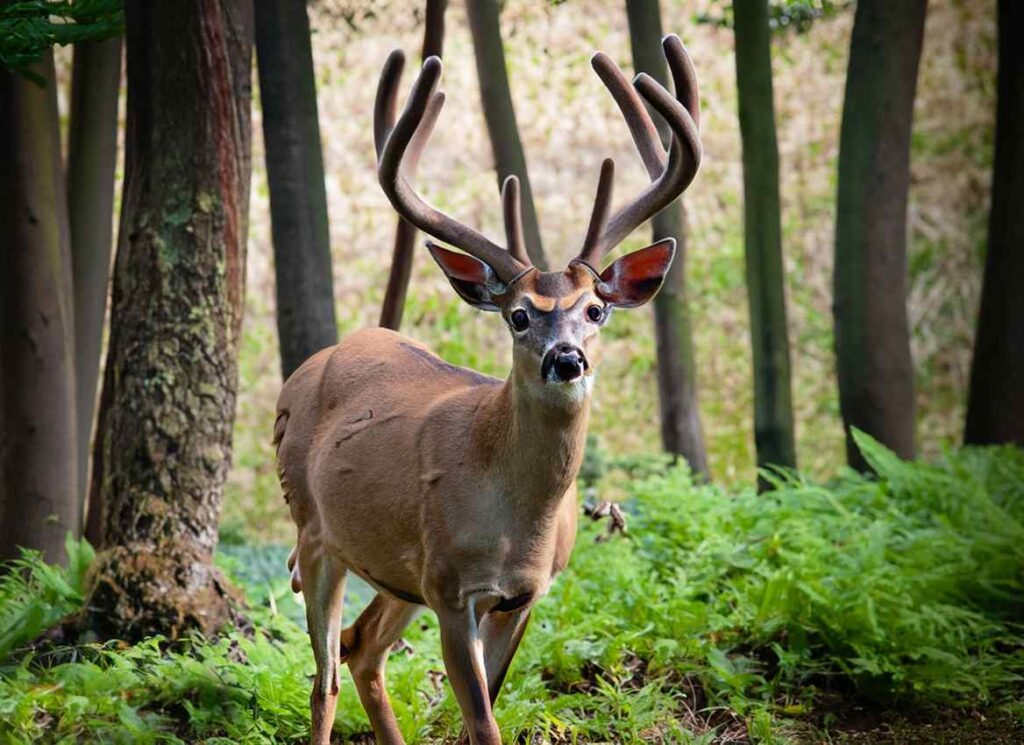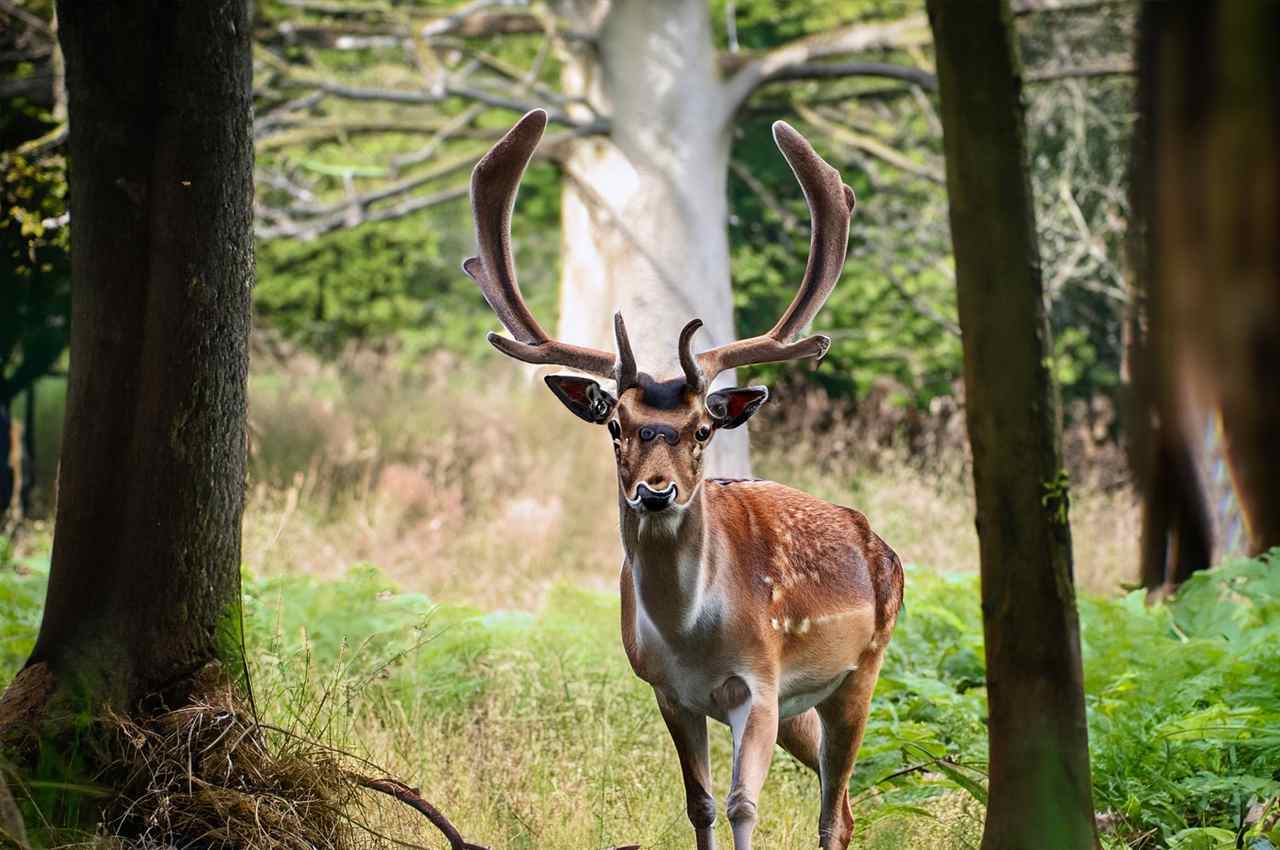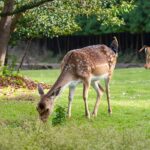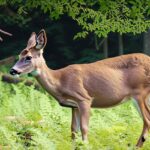How to find deer bedding areas requires a keen understanding of their preferred habitat and behavior. Knowing where the deer are laying on your hunting property will greatly improve your chances of success. The center of a whitetail’s home range is its primary bedding region, which is often overlooked in favor of food sources and pathways. You may learn how to locate these remote refuges and get priceless knowledge about the movements and habits of deer.
How to find deer bedding areas?
Finding regions where deer feel safe and comfortable while resting is essential for locating deer bedding habitats. These regions often display certain traits. Deer look find suitable cover to protect themselves from predators and the weather, such as woodlands, thickets, or tall grass. They also want a high view position, often choosing ridges, slopes, or the margins of clearings so they can keep an eye on their surroundings. Another important element is proximity to food and water sources because it allows deer to satisfy their fundamental requirements without having to expose themselves to danger. Look for indications of deer activity, such as bent or flattened plants, old droppings, footprints, and scrapes, which may help identify probable bedding locations.
Deer Bedding Characteristics
You must search for regions where deer feel secure and at ease in order to locate bedding sites. Deer often roost in places that meet the criteria listed below:

1. Thick Overhead Cover: To defend themselves from avian predators, deer seek for locations with branches, evergreen boughs, bushes, and tall grass. For smell sensing, they often sleep on the downwind side.
2. Felled Trees and Brush Pile Support: Deer may rest against natural supports like felled trees and brush to protect their behind.
3. Slopes and Knolls: Slopes and knolls are high peaks that provide deer the opportunity to view their surroundings while acting as a barrier and windbreak from the uphill side.
4. Seclusion: Deer prefer dense cover or protected areas for bedding rather than close to human activities. The utilization of funnel sections leading to bedding locations is common.
5. Close to Food and Water: Deer prefer to sleep in areas that are close to food and water supplies in order to reduce their exposure to danger. There are exceptions during the rut.
6. Drainage Areas: Low-lying marshes, ditches, and creek bottoms provide a lot of shelter, moisture, shade, and insects. The distinct bedding impressions are left by the soft ground.
7. Droppings: Deer sometimes leave mounds of at least a few-day-old droppings in their bedding sites.
8. Tracks: Deer trails may be seen in locations with soft vegetation, such mud or sand.
9. Scrapes: Near their bedding sites, deer bucks often produce scrapes in the ground. The deer has scratched the ground and rubbed its antlers against the trees in regions known as scrapes.
10. High Vantage Point: Deer like having a high vantage point from which to observe their surroundings. They could rest on peaks, hillsides, or close to the edge of a clearing.
11. Bent or Flattened Vegetation: Deer often roost in places with dense vegetation that offers excellent shelter. Keep an eye out for any locations where the grass, plants, or trees have been twisted or flattened.
These traits make it easier for hunters and wildlife lovers to locate deer bedding places.
Finding Deer Beds
Once you have located sites that fit this description, you may begin searching for evidence of deer bedding. These indicators include:

- Bedded areas: Deer bedding often have an indent in the middle and an oval or circular form.
- Deer droppings: Deer droppings are generally dark or black in color and pellet-shaped.
- Deer footprints: While cow tracks have four hooves on each foot, deer tracks only have two.
- Deer hair: Where deer have brushed their antlers on trees or plants, deer hair is sometimes observed.
If you come across any of these indicators, you have probably discovered a deer bedding place. Deer may leave their bedding place if they feel threatened, so take care not to disrupt it.
Additional recommendations for locating deer bedding places are provided below:
- During the winter, when deer are less active and their bedding places are more obvious, keep an eye out for deer bedding areas.
- Keep an eye out for deer bedding places in locations near supplies of food and water.
- To look for deer and evidence of deer bedding up close, use binoculars or a spotting scope.
- Be watchful and patient. Finding deer bedding sites may take some time, but if you want to be successful at shooting or watching deer, it is worth the effort.
Please be aware that it’s crucial to respect the deer’s resting area and to keep your distance. If you come across a deer bedding place, it is better to just keep your distance and watch the deer.
Times for Hunting Bedding Areas
| Hunting Time | Season/Conditions | Tips and Considerations |
|---|---|---|
| Early Season | Early bow hunting | Excellent for hunting and reconnaissance before to the rut. |
| Morning | Various seasons | Between 6:00 and 10:00 in the morning, deer move into their bedding places. |
| Mid-day | Various seasons | If not too near to places used for food or bedding, effective. |
| Late Season | Late season, cold mornings | After severely chilly and freezing mornings, seek warm ones. |
| Rut | Rut season | It is possible to have success hunting buck bedding regions from behind. |
| Warm Mornings | Late season | The best mornings for hunting are those that come after frigid ones. |
| Before Sunset | Various seasons | Approximately 30 to 60 minutes before nightfall, deer often leave their beds to eat. |
| Winter | Winter season | Deer may bed over 85% of the time, with the height of their daytime activity right before dusk. |
Why Find Deer Beds?
Finding buck bedding locations enables you to:

• Go hunting nearer to where deer spend the most of the day.
• Predict the routes taken by deer to and from their beds.
• Pinpoint key sites to prevent spookiness in deer
• Look for shelters and locations for trail cameras.
• Surround beds with sanctuaries and funnels.
Deer normally sleep near cover during the day and only move away to forage or reproduce. You have a great possibility of ambushing moving deer when you hunt along routes that go to or from bedding sites.
Patterning Deer Beds
When you come across a deer bed, think about what attracted you to that location. Cover, topography, food supplies, wind direction, and the absence of human activity were all important factors. You can find more beds in the future by knowing why deer choose that location.
Count the number of beds that are crowded together as well. Typically, single beds denote lone bucks. Bed clusters represent doe family groupings. Bucks often rest close outside and to the side of doe herds.
Lastly, once the season starts, avoid applying too much pressure on bedding areas. To pattern beds from a distance, use trail cameras, observations, and personal experience. To capture bucks moving at last light, sneaking into a pre-positioned stand close to a bedding area just before daybreak is a successful strategy.
Creating Better Bedding Areas
Bedding spaces may be made more appealing by:
- Cutting trees at the hinges to provide thicker cover
- A piler to create beds for the earth
- Planting shady plants on the downwind side.
- Making backrests out of deadfall structures
- Cleaning up the shooting lanes on the feeding routes
- Establishing refuges free from human interference.
Deer are kept concentrated in certain places for greater hunting possibilities by funneling their movement and by creating beds.
Unlocking Success: Using Bedding Intel to Strategically Tag Deer
One of the most crucial pieces of knowledge you may have while deer hunting is bedding information. You may improve your chances of success and put up stands in the ideal areas by being aware of where deer are sleeping.
There are many methods for gathering bedding information. During the winter, when deer are less active and their bedding sites are more obvious, you may scout for these locations. Trail cameras may also be used to spot deer bedding places and keep an eye on deer activities.
Here are some pointers for strategically tagging deer using bedding information:
1. Scout for bedding areas during the winter. During the winter, scout potential sleeping sites. You may search for evidence of deer bedding using binoculars and a spotting scope when the animals are less active and their bedding patches are more obvious. Seek for locations that are well-covered, elevated, and close to food and water.
2. Use trail cameras to monitor deer activity. To keep an eye on deer activities, use trail cameras. For acquiring information about bedding, trail cameras may be an invaluable tool. Install cameras close to probable bedding places to track deer movement patterns and verify that the location is being used by deer.
3. Once you have identified a bedding area, develop a plan for hunting it. When positioning your stand, take into account the wind’s direction, deer movement patterns, and the time of day when deer are most active.
4. Be calm and patient. When seeking bedding areas, it’s crucial to remain quiet and patient since deer have keen hearing and smell senses.
5. Be willing to attempt a long shot. Be ready to take a long shot if required since deer are sometimes most susceptible while they are traveling to and from their bedding sites.
Here are some more pointers for carefully tagging deer using bedding information:
- Go on a hunt in the morning or at night. Deer are most active during these hours as they go to and from their sleeping sites.
- Pay attention to locations that are near supplies of food and water. Focusing on these places might improve your chances of success since deer often roost close to food and water supplies.
- Wear and use camouflage-patterned gears. By doing so, you’ll be better able to blend in with your surroundings and reduce the likelihood that the deer will notice you.
- Pay attention to the deer’s rutting habits. Bucks may alter their sleeping locations and travel routes throughout the rut. Make careful to modify your hunting tactics as necessary.
Factors should be considered when hunting deer in bedding areas
| Factor to Consider | Tips for Success When Hunting Deer in Bedding Areas |
|---|---|
| Understand the property | Understand the topography, food supplies, and probable bedding locations. |
| Chart all trail networks | To find prospective bedding spots and transit routes, map out the trail networks. |
| Know how the wind works | To prevent scare deer, hunt on the side that is downwind. |
| Finding un-pressured areas | Find regions where deer feel secure and unbothered. |
| Look for evidence of bedding | Look for circular craters where deer have buried themselves. |
| Hunt the fringes of bedding | Set up on the periphery to watch activity without alarming deer |
| Hunt the downwind side | To prevent the aroma from permeating the bedding, position yourself downwind. |
| Be patient | Be prepared to stay in a stand for a long time; success may not come quickly. |
Frequently Asked Questions
What is the best time to find deer bedding areas?
Depending on the season and the particular situation, different times are optimum for locating deer bedding sites. Finding these spots during the early season of bow hunting, usually in late summer or early October, might be fruitful. If you don’t want to frighten the deer, midseason may be best. Hunting close to doe bedding sites during the rut, which typically takes place in November, may be productive. Earlier in the day, early morning hunts in bedding areas may be successful. To maximize your chances of a successful hunt, it is ideal to schedule your searches for deer bedding sites well before deer season. This will enable you to do in-depth reconnaissance and strategic preparation.
How do I approach a deer in its bedding area?
You should put stealth and patience first if you want to effectively approach a deer in its resting area. They have a keen sense of smell, so move slowly, silently, and with little noise while keeping downwind to avoid being discovered. As you go closer, using binoculars to survey the area might help you locate the deer without frightening them. In order to watch activity without frightening the deer, look for indications of bedding, such as oval depressions, and consider setting up along the edges of these regions. When the wind is in your favor, you should also approach from the most visible feeding location toward the bedding area. In order to improve your chances of a successful approach, timing, direction, and a thorough grasp of deer behavior in their bedding regions are crucial.
What are some common mistakes when hunting for deer?
Success in deer hunting depends on avoiding typical blunders. Inadequate practice, checking trail cameras too frequently, not being aggressive in your approach, ignoring high-odds days, failing to eliminate scent, hunting prime areas too soon, driving in the middle of the day, impatience, insufficient scouting, and failing to take wind direction into account are some of these mistakes. For a successful hunt, mastering shooting techniques, strategic reconnaissance, and scent management are essential. Your hunting results may be greatly enhanced by being persistent, hunting in excellent weather, and reserving top places for optimal conditions. For a responsible and effective hunting experience, always abide by local hunting laws and safety precautions.
How do you tell if a deer has a bedding area?
The presence of rubs near solitary beds for bucks, southwest-facing slopes offering wind and sun, thick cover such as brush or coniferous swamps, somewhat open areas with good visibility, sanctuaries devoid of human activity, strategically placed trail cameras to monitor deer movement, oval depressions in the ground where deer have lain down, clustered beds that indicate doe or buck bedding, southwest-facing slopes offering wind and sun, thick cover such as brush or coniferous swamps, While following local hunting laws and safety precautions is crucial, these indicators may assist hunters in locating deer bedding sites. Hunting success is never assured.
Where are common deer bedding areas?
Common deer bedding areas can include dense cover such as streamside brush or coniferous swamps, southwest-facing slopes that provide wind and sunlight, somewhat open areas with good visibility, refuges free of human activity, low flats within changing topography, tall grasses offering cover, and rock escarpments providing protection and shade. Although locating these places might assist hunters in finding probable deer bedding sites, hunting success is never assured, thus adherence to regional hunting laws and safety precautions is crucial.
How do you find bedding areas for bucks?
You could start by looking generally for prospective habitat characteristics that bucks would like, such as knobs off ridges, peninsula-like landforms in wetlands, or islands in swamps, to discover buck bedding locations. A great tool for locating these features is aerial imaging. To watch deer behavior, search for rub clusters and think about scouting early in the season. In the autumn, particularly, bucks often choose grassy, stemmy, stalky regions to wood. These techniques may assist you in identifying probable buck bedding places, but hunting success cannot be assured, and respect to regional hunting laws and safety precautions is crucial.
How far will deer travel from bedding to food
Deer can travel up to a mile or more between their bedding and food, depending on the terrain, the availability of food, the time of year, and the deer’s home range. Mature deer typically cover this distance within 100 to 150 yards during the day. For hunting to be successful, it is essential to comprehend these factors and explore the region to find deer travel routes and feeding places. By doing this, hunters may strategically place themselves to catch deer during their daily movements.
How often do deer use the same bedding area?
Deer may utilize the same bedding location more often than others, but on average, bucks prefer to use the same bed approximately once every 3–4 days, whereas deer normally do not bed in the same place every day. They often have various bedding spots, and if they sense danger or disturbance, they may change their location. Additionally, the amount of hunting pressure and the time of year may affect how often bucks move; during the rut, bucks may move more in search of a mate. For effective hunting, scouting the region and studying deer behavior are crucial.
What are some reasons why deer might switch bedding areas?
Due to pressure from hazards like hunting or human activity, changes in food supplies or habitat, unfavorable weather, the pursuit of mates during the rut, and the presence of predators, deer may vary their bedding locations. To secure their safety and fulfill their fundamental requirements, deer may move to other bedding sites as a result of these reasons. Understanding these possible causes for changes in bedding areas is essential for effective deer hunting. You may adjust your hunting tactics by scouting and studying deer behavior.
What time do deer get out of their beds?
The time that deer get out of their beds can vary, but it generally falls within a range of 6:00 am to 11:00 am, when they return to their bedding quarters. With considerable fluctuation based on variables including the time of year, weather, and individual deer activity levels, they typically sleep in their beds for 3–4 hours before rising. Around 30 minutes to an hour before sundown, deer may also leave their bedding to forage, however when there is cloud cover, they may leave sooner. Also keep in mind that early season bow hunts, pre-rut, rut, and late season hunts are the greatest times to go deer hunting near bedding places. For hunters that want to efficiently plan their hunting techniques, understanding these trends might be helpful.
What should I look for when trying to identify deer bedding areas?
Look for regions with plenty of cover, a clear line of sight, ideal wind conditions, and some sunlight to detect deer bedding sites. When bucks are not under threat, these locations are often close to food and water supplies. Slopes that face the southwest may also make excellent bedding areas since they provide warmth and a wind advantage. Additionally, pay attention to places that have been designated as sanctuaries and have little human activity.
How can I distinguish between buck bedding and doe bedding areas?
Bucks often lie down with the wind at their backs so they can see downwind and smell potential prey. This often leads to isolated or grouped beds with white belly hairs or areas of worn-down plants. On the other hand, does and buck bachelor groups depend more on their eyes for protection, causing them to position their bedding facing various directions.
What is the importance of precision when hunting in deer bedding areas?
When hunting close to deer bedding regions, accuracy is essential. The trick is to enter these locations covertly and without alarming the deer. An little sound or smell might startle adult bucks, jeopardizing your hunt. You may enter and depart the stand covertly using pre-set stands like hang-ons, ladders, or tri-pods, which improves your chances of success.
How can I improve deer bedding areas on my property?
By hinge-cutting trees to generate heavier cover in the winter, you may enhance deer bedding sites. To keep these locations appealing to deer, avoid disturbing them as well. Bucks will be attracted to the bedding areas if they are kept free of pebbles and sticks and even if grass is planted there.
Conclusion
Finally, locating deer bedding places may be a difficult but worthwhile endeavor. You may improve your chances of locating these crucial sites by being aware of the characteristics of deer bedding regions and the indications of deer bedding.
From this article, remember the following main points:
- Deer often choose to sleep in places with decent cover, a good view position, and access to food and water.
- Bedded areas, deer droppings, deer footprints, and deer hair are indications that deer are bedding.
- Since deer are less active and their bedding locations are more obvious in the winter, this is the ideal time to search for deer bedding areas.
- Keep an eye out for deer bedding places in locations near supplies of food and water.
- To look for deer and evidence of deer bedding up close, use binoculars or a spotting scope.
- Be watchful and patient. Finding deer bedding sites may take some time, but if you want to be successful at shooting or watching deer, it is worth the effort.
Once you have located a deer bedding place, it is crucial to respect it and refrain from upsetting the deer. If you come across a deer bedding place, it is better to just keep your distance and watch the deer.
- California Deer Hunting Guide: Seasons, Rules, Permits, and More - 26 June 2024
- Arkansas Deer Season 2024 [Schedules, Licenses, Bag Limits & More!] - 26 June 2024
- 2024 Arizona Deer Season New Dates & Rules! - 25 June 2024




